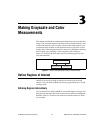Chapter 2 Getting Measurement-Ready Images
© National Instruments Corporation 2-11 IMAQ Vision for Visual Basic User Manual
Use CWIMAQVision.GrayMorphology to perform one of the following
seven transformations:
• Erosion—Reduces the brightness of pixels that are surrounded by
neighbors with a lower intensity.
• Dilation—Increases the brightness of pixels surrounded by neighbors
with a higher intensity. A dilation has the opposite effect of an erosion.
• Opening—Removes bright pixels isolated in dark regions and smooths
boundaries.
• Closing—Removes dark pixels isolated in bright regions and smooths
boundaries.
• Proper-opening—Removes bright pixels isolated in dark regions and
smooths the inner contours of particles.
• Proper-closing—Removes dark pixels isolated in bright regions and
smooths the inner contours of particles.
• Auto-median—Generates simpler particles that have fewer details.
FFT
Use the Fast Fourier Transform (FFT) to convert an image into its
frequency domain. In an image, details and sharp edges are associated
with mid to high spatial frequencies because they introduce significant
gray-level variations over short distances. Gradually varying patterns are
associated with low spatial frequencies.
An image can have extraneous noise, such as periodic stripes, introduced
during the digitization process. In the frequency domain, the periodic
pattern is reduced to a limited set of high spatial frequencies. Also, the
imaging setup may produce non-uniform lighting of the field of view,
which produces an image with a light drift superimposed on the
information you want to analyze. In the frequency domain, the light drift
appears as a limited set of low frequencies around the average intensity of
the image, which is the DC component.
You can use algorithms working in the frequency domain to isolate and
remove these unwanted frequencies from the image. Complete the
following steps to obtain an image in which the unwanted pattern has
disappeared but the overall features remain:
1. Use
CWIMAQVision.FFT to convert an image from the spatial domain
to the frequency domain. This method computes the FFT of the image
and results in a complex image representing the frequency information
of the image.


















